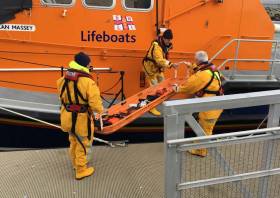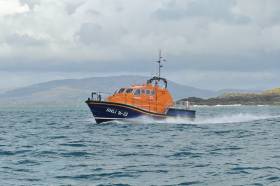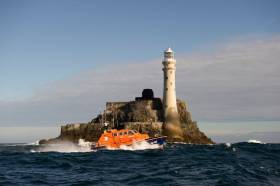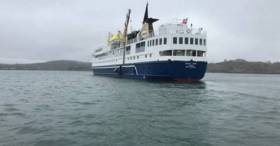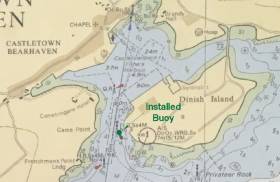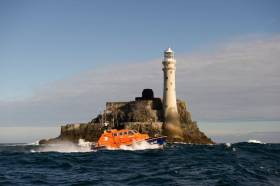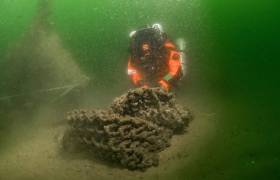Displaying items by tag: west cork
Baltimore Lifeboat In Medevac From Cape Clear Island
#RNLI - Baltimore RNLI carried out a medical evacuation yesterday afternoon (Wednesday 25 July) from Cape Clear Island off the coast of West Cork.
The volunteer lifeboat crew launched their all-weather lifeboat following a request from the Irish Coast Guard at 1.42pm to provide medical assistance and evacuation to an islander living on Cape Clear.
Arrived in North Harbour at Cape Clear at 2.05pm, four of the volunteer crew went to the casualty’s location to assist with transfer and casualty care.
Once ready, the casualty was brought onboard Baltimore lifeboat and they departed the island at 3.07pm. The lifeboat returned to station in Baltimore and handed the casualty over to the care of HSE ambulance crew at 3.51pm.
Conditions at sea during the call out were relatively calm, with a south-westerly Force 3-4 wind and one-metre sea swell.
Speaking after the callout, Baltimore RNLI volunteer lifeboat press officer Kate Callanan said: ‘Medical evacuations — medevacs — are a regular service that Baltimore RNLI provide between the mainland and islands, and also between the mainland and private and commercial boats at sea.
“If you find yourself in need of medical assistance, call 999 or 112 and ask for the coastguard.”
There were six volunteer crew onboard the lifeboat: coxswain Aidan Bushe, mechanic Cathal Cottrell and crew members Eoin Ryan, Kieran Collins, Emma Lupton and Don O’Donovan.
Baltimore Lifeboat In Two Friday Callouts To People In Difficulty On Passenger Vessels
#RNLI - Baltimore RNLI has praised the swift actions of one of its volunteer crew members in the rescue a man taken ill on a passenger vessel in West Cork yesterday afternoon (Friday 25 May).
In the first of two callouts yesterday, the all-weather lifeboat was requested to launch at 12.50pm following a report of man in difficulty on a small passenger vessel west of The Stags.
Weather conditions at the time were described as slightly choppy with a Force 3 easterly wind.
The skipper of the passenger vessel, a long-serving volunteer crew member with Baltimore RNLI, had immediately administered casualty care to the man when he started to show signs of being in difficulty, and the man was already in the recovery position as the lifeboat arrived minutes later.
Once on scene, the casualty was transferred onto the lifeboat where the crew continued to administer casualty care as he was brought back to Baltimore.
The man was then transferred into the care of paramedics and a waiting ambulance before he was brought to hospital for further treatment. Volunteer crew member Sean McCarthy provided assistance at Baltimore Lifeboat Station.
“All at Baltimore RNLI would like to wish this man a full and speedy recovery following his ordeal,” said Tom Bushe, Baltimore RNLI lifeboat operations manager.
“[The callout was] a fine example of how the RNLI’s lifesaving training can make a real difference and I would particularly like to praise the efforts of Micheal Cottrell, skipper of the small passenger vessel, who used his skills as a crew member to help bring this man to safety before the lifeboat arrived on scene.”
Baltimore RNLI has been called out for a second time today (Friday 25 May) to a separate incident to a woman who got into difficulty on a passenger vessel in West Cork.
Later in the afternoon, the volunteer lifeboat crew launched their all-weather lifeboat at 4.25pm following a request to provide a medevac for the woman about one mile southwest of the Kedge.
The casualty was transferred immediately to the lifeboat when it arrived on scene 10 minutes after launch. Casualty care was administered by the crew while the lifeboat made its way back to Baltimore lifeboat station.
Once at the station, casualty care was continued by the lifeboat crew until the HSE ambulance, a local GP and the Irish Coast Guard helicopter from Waterford, Rescue 117, arrived and took over care.
#RNLI - Baltimore RNLI carried out a medevac yesterday morning (Monday 21 May) from Cape Clear Island off the coast of West Cork.
The volunteer lifeboat crew were asked to launch their all-weather lifeboat following a request from the Irish Coast Guard at 7.53am to provide medical assistance and evacuation to a man living on the island.
The all-weather lifeboat arrived in Cape Clear at 8.25am and the casualty was transferred to the care of the volunteer crew onboard.
The lifeboat then returned to Baltimore lifeboat station at 8.55am and handed the casualty over to the care of HSE ambulance crew once they arrived at the station.
Conditions at sea during the shout were flat calm with a north-easterly Force 3 wind.
There were seven volunteer crew onboard the lifeboat: coxswain Aidan Bushe, mechanic Cathal Cottrell and crew members Brendan Cottrell, Micheal Cottrell, Jerry Smith, Emma Lupton and Don O’Donovan. Kieran Cotter provided shore crew assistance at the lifeboat house.
Speaking following the callout, Baltimore RNLI volunteer lifeboat press officer Kate Callanan said: “Baltimore lifeboat regularly provides medical assistance and transfers for people living, working or holidaying on the islands.
“This call is the third medical evacuation for Baltimore RNLI in the past two weeks.
“Always remember, if you find yourself at sea or on an island in need of medical assistance, call 999 or 112 and ask for the coastguard.”
RNLI Lifeboats In Medevac Shouts At Baltimore & Wicklow
#RNLI - Baltimore RNLI carried out a medevac on Saturday night (12 May) from Cape Clear Island off the coast of West Cork.
The volunteer crew were requested to launch their all-weather lifeboat by the Irish Coast Guard at 8.05pm to provide medical assistance and evacuation to a man working on the island.
Arriving in Cape Clear at 8.24pm, the RNLI volunteers transferred the casualty onto the lifeboat and returned him to Baltimore lifeboat station, whee he was handed over to the care of a waiting HSE ambulance crew.
Conditions at sea during the shout were calm with a south-westerly Force 3 wind and half-metre sea swell.
“So far this year medical evacuations make up a high percentage of the call outs for Baltimore lifeboat,” said Kate Callanan, Baltimore RNLI volunteer lifeboat press officer.
“Acting as an ambulance between the islands off the coast of West Cork is a vital service and our volunteer crews are trained to a high standard in first aid and casualty care.
“If you find yourself at sea or on an island in need of medical assistance, call 999 or 112 and ask for the coastguard.”
Hours later, Wicklow RNLI’s inshore lifeboat crew were alerted by pager shortly after 3.10pm yesterday afternoon (Sunday 13 May) to assist in the medic of an injured sailor in the town’s harbour.
The sailor was being treated on a yacht by first responders and HSC paramedics at the East pier after he sustained injuries while sailing in Wicklow Bay.
The lifeboat was requested to launch in case the casualty was seriously injured and needed to be evacuated from the yacht to a more suitable location for transfer to an ambulance.
The lifeboat, with helm Alan Goucher and crew Terry Sillery and Paul Sillery, was about to launch when lifeboat operations manager Des Davitt was made aware that the casualty was assisted up a ladder onto the pier after being treated by paramedics, and no further assistance was required.
#RNLI - Baltimore RNLI launched on Monday evening (7 May) to carry out a medical evacuation for a man from Sherkin Island off the West Cork coast.
The volunteer lifeboat crew arrived on scene at 7.40pm, just eight minute after launch, and provided casualty care before transferring the patient to the all-weather lifeboat and returning to Baltimore, where he was handed over to the HSE ambulance crew at 8.30pm.
Weather conditions were good at the time, with a south-westerly Force 2-3 wind and calm sea conditions within the harbour.
The volunteer crew onboard the lifeboat were coxswain Kieran Cotter, mechanic Cathal Cottrell and crew members Pat Collins, Aidan Bushe, Jerry Smith, Eoin Ryan, Don O’Donovan and Ronnie Carty.
Speaking following the callout, Baltimore RNLI volunteer lifeboat press officer Kate Callanan said: “The RNLI and other rescue agencies around the coast provide a vital service to those living or holidaying on islands. If you require assistance, please call 999 or 112 and ask for the coastguard.”
Cape Clear Port of Call A First By Cruise Ship
#CruiseLiners - For the first time ever a cruise ship called to the West Cork island of Cape Clear last Thursday morning with a group of 70 bird watchers.
Guests on the cruise ship Ocean Nova, writes the Evening Echo, were escorted by guides from Birdwatch Ireland who have a manned bird observatory on the island, and visited some of the island’s prime birdlife, wildlife, and marine life viewing spots.
While the main focus of the visit was birdwatching, they also took time to visit the island’s museum which depicts life on Cape Clear, past and present, and view its impressive exhibit about the building of the iconic Fastnet Rock.
Upon departure, the ship sailed around Fastnet and entered Schull Harbour, another first.
From there, coaches brought passengers to the Mizen Head Signal Station and Visitor Centre where they enjoyed not only the scenery, but observed the bird and marine life in this area.
To read more on the story, click here.
Buoy Change At Castletownbere Fishery Harbour Centre
#MarineNotice - Marine Notice No 13 of 2018 advises that the No 3 Green Perch at the entrance to Castletownbere Fishery Harbour Centre in West Cork has been removed due to damage.
The No 3 Green Perch has been replaced by a 1.5m green buoy in position 51° 38’ 49.387” North, 09° 54’ 27.41” West.
The light characteristic is a green flash every five seconds. This buoy will remain in position until further notice.
For safety reasons, mariners are requested to proceed slowly and with caution when in the vicinity of the green buoy.
For further information, contact the Castletownbere Harbourmaster’s Office at +353 27 70220.
Baltimore Lifeboat Launches To Broken Down Trawler
#RNLI - Baltimore RNLI were called out in the early hours of yesterday morning (Friday 23 March) to a fishing trawler with five people on board which had broken down close to shore.
The volunteer lifeboat crew launched their all-weather lifeboat at 5.20am after the Irish Coast Guard requested assistance for a 22m fishing trawler that had suffered engine failure close to the shoreline off the West Cork harbour’s mouth.
Arriving on scene six minutes later, the lifeboat found the casualty vessel had an anchor shot and the crew, all in lifejackets, were working to resolve their mechanical difficulties. Weather conditions at the time had a south-westerly Force 5 wind and a 1.5m sea swell with good visibility.
Within 20 minutes, the trawler was underway by its own power, under escort of the Baltimore lifeboat, to the safety of Baltimore Harbour.
Speaking following the callout, Baltimore RNLI volunteer lifeboat press officer Kate Callanan said: “If your boat is in danger close to the shoreline, always remember to try not to panic.
“Use the resources available such as deploying an anchor, ensure all people aboard are in lifejackets and seek assistance as soon as possible. If you get into difficulty at sea or on the coast, call 999 or 112 and ask for the coastguard.”
The volunteer crew on this callout were coxswain Kieran Cotter, mechanic Cathal Cottrell, Pat Collins, Davie Ryan, Colin Whooley, Aidan Bushe, Emma Lupton and Don O’Donovan. Sean McCarthy assisted at Baltimore lifeboat station.
Elsewhere on the Irish coast, Skerries RNLI launched to reports of individuals in distress on two separate occasions earlier this week.
Shortly after 4am on Monday morning (19 March), Skerries volunteers launched their Atlantic 85 inshore lifeboat after Dublin Coast Guard received a call that a person in distress had entered the water near Laytown.
The lifeboat, with Emma Wilson at the helm and crewed by Steven Johnson, JP Tanner and Paddy Dillon, had just launched the boat when they were stood down as a garda had managed to help the person ashore to a waiting ambulance.
The lifeboat launched again on Tuesday evening (20 March) shortly after 11.30pm, this time helmed by Peter Kennedy with volunteers Jack Keane, JP Tanner and Paddy Dillon on board.
Concerns had been raised about a person who was in danger of entering the water near Bettystown. Again the lifeboat was stood down shortly after launching as shore-based emergency services had taken the person into their care.
Speaking about the callouts, Skerries RNLI volunteer lifeboat press officer Gerry Canning said: “It’s been a restless start to the week for our volunteers, but they are always ready to answer any call for help.
“The most important thing is that there wasn’t a tragic outcome in either case and we hope that the casualties make a full and speedy recovery.”
Baltimore Lifeboat On 11-Hour Callout To Assist Trawler
#RNLI - Baltimore RNLI were called out on Monday afternoon (26 February) to a fishing trawler that had broken down 50 miles south of Baltimore in West Cork.
The volunteer lifeboat crew launched their all-weather lifeboat at 2.12pm after the Irish Coast Guard requested that they go to the assistance of a 24m French-registered fishing trawler, with five people on board, that had suffered engine failure.
Arriving on scene at 4.25pm, the lifeboat crew had a tow established to the casualty vessel and were proceeding back to Baltimore within 10 minutes. One of the lifeboat volunteers, Youen Jacob, is fluent in French and was able to communicate with the trawler crew for the duration of the callout.
Weather conditions at the time were difficult, with an east southeasterly Force 6-7 wind and a four-metre sea swell, but visibility was good.
During the return to Baltimore Harbour, the tow proved difficult at times due to the weight of the casualty vessel and sea conditions, and at one point, shortly before 11pm, the tow disconnected for a short time.
Due to conditions in the harbour and the size of the casualty vessel, lifeboat coxswain Kieran Cotter decided that Baltimore’s inshore lifeboat should be launched to assist in bringing the trawler alongside the pier in Baltimore.
The smaller boat launched at 11.45pm to meet the all-weather lifeboat at the harbour’s entrance and escorted the two vessels to the pier, arriving at 12.20am, and the trawler was finally manoeuvred alongside and tied up at 1.15am.
Speaking following the callout, Baltimore RNLI volunteer lifeboat press officer Kate Callanan said: “It was helpful that the Irish Coast Guard notified us in advance of launching that the fishing trawler crew had no English as we were able to choose a fluent French speaker as one of our lifeboat volunteers.
“Thanks to Youen being able to communicate between the fishing vessel and the lifeboat both crews knew what was required throughout the rescue.”
The six volunteer crew onboard the all-weather lifeboat were coxswain Kieran Cotter, mechanic Pat Collins and crew members Aidan Bushe, Sean McCarthy, Youen Jacob and Jim Griffiths. Three volunteer crew onboard the inshore lifeboat were helm Micheal Cottrell, Ryan O’Mahony and Paul Synott. Assisting at Baltimore lifeboat station were Marty O’Driscoll, Ronnie Carthy, Pat O’Driscoll, Cathal Cottrell, Kieran Collins, Colin Whooley and Simon Duggan.
Project To Tackle ‘Ghost Fishing’ Scourge Coming To Ireland This Summer
#Fishing - Marine wildlife worldwide continues to fall victim to ‘ghost fishing’, trapped in lost or abandoned fishing gear.
The situation prompted a group of experienced divers, who often come across discarded nets and other debris, to form the Ghost Fishing Foundation — which co-ordinates cleanups in the US, the North Sea coast and the Mediterranean.
And this summer, as Coast Monkey reports, the initiative is coming to Ireland with the Big Ghost Net Removal Project.
Organisers are currently crowdfunding for the week-long cleanup which will see as many as 17 divers removing nets from the waters of West Cork, a popular location for dolphins and whales.
Coast Monkey has more on the story HERE.



























